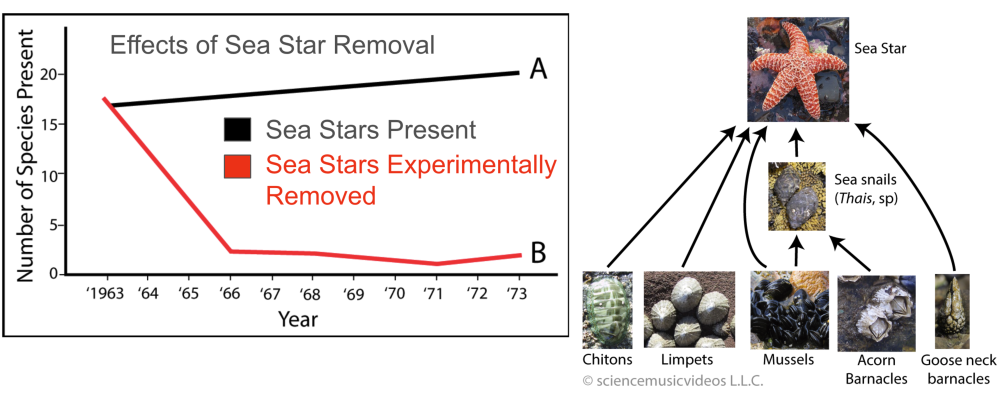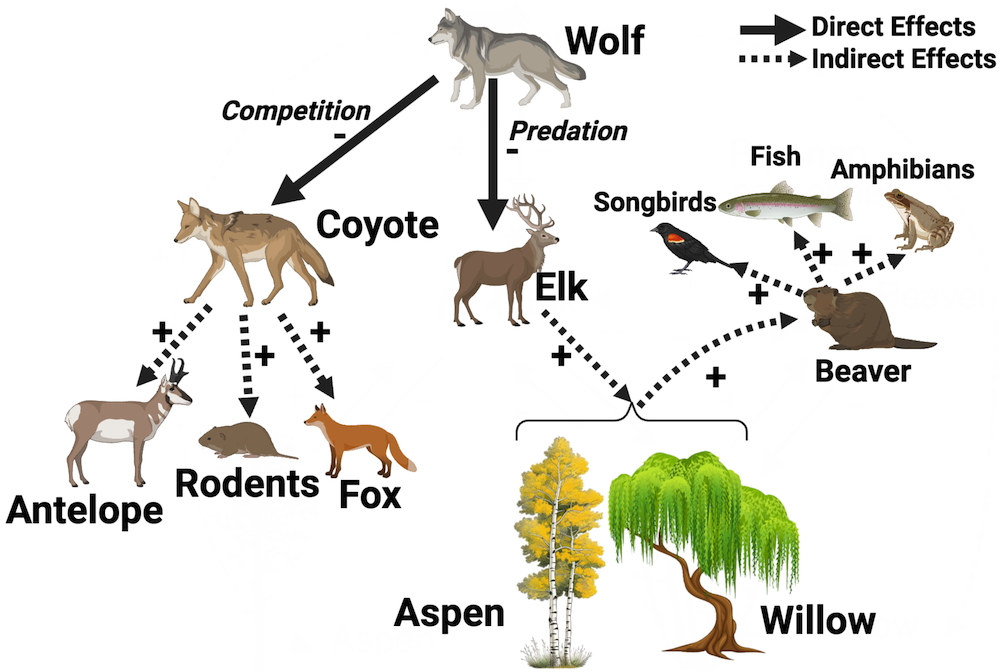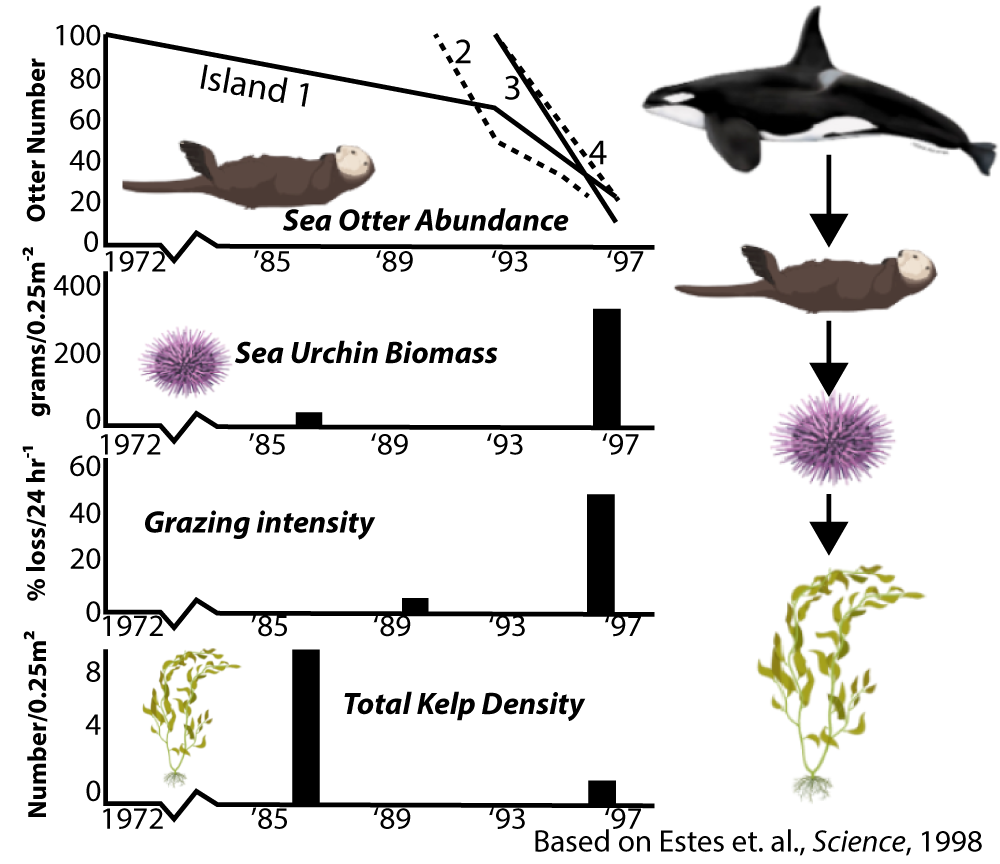1. Watch this Video
2. Study this Summary
Keystone Species and Trophic Cascades
Keystone species:
- organisms that have a disproportionately large impact on their ecosystems relative to their abundance.
- They’re usually predators that help maintain the structure of a biological community by regulating populations of other species, often preventing the dominance of a single species that could reduce biodiversity.
Trophic cascade
- an ecological process triggered by the addition or removal of a key species – usually the keystone species.
- This removal causes significant changes in population sizes and interactions throughout the food web.
- These cascades can have far-reaching effects on ecosystem structure and biodiversity.
Illustrative Example 1: Sea Stars in the Intertidal Zone

- Sea stars are predators in the intertidal zone, preying on various organisms, particularly mussels.
- By controlling mussel populations, sea stars create ecological space for other invertebrates, sustaining biodiversity.
- A famous experiment by Robert Paine in the 1960s demonstrated this effect—when sea stars were removed (line B, above) , mussels overgrew the habitat, reducing species diversity.
Wolves in Yellowstone National Park

- Wolves were reintroduced to Yellowstone in the 1990s after being eradicated by overhunting.
- In the wolves’ absence, elk populations had overgrazed aspen and willow trees, leading to habitat loss.
- When wolves returned, elk numbers declined, allowing vegetation to recover. This, in turn, supported beavers, who built dams that enhanced aquatic habitats, increasing biodiversity.
- Wolves also reduced coyote populations, indirectly benefiting smaller prey species like foxes, rodents, and antelope.
Otters and Kelp Forests

- Otters are the keystone species in the kelp forest ecosystem. By preying on sea urchins, they maintain the diversity of the kelp forest ecosystem.
- A study in Alaska found that orcas shifting their diet from seals to otters disrupted the ecosystem.
- Fewer otters led to an unchecked sea urchin population, which overgrazed kelp forests, causing ecosystem decline.
- Data from the study showed a clear trophic cascade—otter reduction led to more sea urchins, higher grazing intensity, and a decline in kelp density.
Beavers as Ecosystem Engineers
- Not all keystone species are top predators—beavers shape ecosystems by building dams, which create habitats for many species and increase biodiversity.
3. Master these Flashcards
[qdeck bold_text=”false” style=”width: 700px !important; min-height: 450px !important;” qrecord_id=”sciencemusicvideosMeister1961-Keystone Species and Trophic Cascades Flashcards, APBioVideoPath”]
[h] Keystone Species and Trophic Cascades Flashcards
[i]
[start]
[q json=”true” yy=”4″ unit=”8.Ecology” question_number=”416″ topic=”8.5-6.Community_Ecology_and_Biodiversity” dataset_id=”AP_Bio_Flashcards_2022|32de88c37d7c8″] What are keystone species? In your response, use the example of sea stars in the intertidal zone.
[a] A keystone species is one whose action within a biological community structures the entire community. Frequently, keystone species are predators who keep a particular herbivore in check. The result is an increase in the overall biodiversity of the community.
[q json=”true” yy=”4″ unit=”8.Ecology” question_number=”417″ topic=”8.5-6.Community_Ecology_and_Biodiversity” dataset_id=”AP_Bio_Flashcards_2022|32d7421e54fc8″] Using the example of sea stars in the intertidal zone, explain how keystone species promote biodiversity.
[a] A famous example of a keystone species is the role of sea stars in controlling mussel populations in the rocky intertidal zone. By preying on the mussels, the sea stars create ecological space for a variety of other invertebrates to live in this community. When sea stars were experimentally removed, the mussels overgrew the entire zone, and species diversity fell.
[q json=”true” yy=”4″ unit=”8.Ecology” dataset_id=”AP_Bio_Flashcards_2022|10a701f13e110″ question_number=”418″ topic=”8.5-6.Community_Ecology_and_Biodiversity”] As it relates to ecosystem diversity and structure, what is a “trophic cascade?”
[a] Trophic cascades occur when a trophic level within an ecosystem is suppressed, usually by a predator — a keystone species — that reduces the activity of an herbivore. This, in turn, increases the overall biodiversity of an ecosystem by increasing the ecosystem’s productivity and by creating ecological space for other herbivores and producers.
[q]Using this diagram, explain the effects of wolf reintroduction into Yellowstone National park.
- Wolves were reintroduced to Yellowstone in the 1990s after being eradicated by overhunting.
- In the wolves’ absence, elk populations had overgrazed aspen and willow trees, leading to habitat loss.
- When wolves returned, elk numbers declined, allowing vegetation to recover.
- This, in turn, supported beavers, who built dams that enhanced aquatic habitats, increasing biodiversity.
- Wolves also reduced coyote populations, indirectly benefiting smaller prey species like foxes, rodents, and antelope.
[q]Using this diagram, explain the trophic cascade that resulted from orcas preying on otters.
[a]
- Otters are the keystone species in the kelp forest ecosystem. By preying on sea urchins, they maintain the diversity of the kelp forest ecosystem.
- A study in Alaska found that orcas shifting their diet from seals to otters disrupted the ecosystem.
- Fewer otters led to an unchecked sea urchin population, which overgrazed kelp forests, causing ecosystem decline.
- Data from the study showed a clear trophic cascade—otter reduction led to more sea urchins, higher grazing intensity, and a decline in kelp density.
[x]
[restart]
[/qdeck]
4. Tackle this Quiz
[qwiz style=”width: 700px !important; min-height: 400px !important;” qrecord_id=”sciencemusicvideosMeister1961-Keystone Species and Trophic Cascades Quiz, APBioVideoPath”]
[h]Keystone Species and Trophic Cascades
[q] Which line below represents the effect of removing sea stars from the intertidal ecosystem?
[textentry single_char=”true”]
[c]IE I=[Qq]
[f]IEV4YWN0bHkuIEFzIFJvYmVydCBQYWluZSBkaXNjb3ZlcmVkLCByZW1vdmluZyBzZWEgc3RhcnMgbGVkIHRoZSBvdmVyYWxsIGRpdmVyc2l0eSBvZiB0aGUgaW50ZXJ0aWRhbCB6b25lIHRvIGRlY3JlYXNlLg==[Qq]
[c]IEVudGVyIHdvcmQ=[Qq]
[c]ICo=[Qq]
[f]IE5vLiBIZXJlJiM4MjE3O3MgYSBoaW50LiBXaGVuIFBhaW5lIHJlbW92ZWQgdGhlIHNlYSBzdGFycywgaXQgYWxsb3dlZCB0aGUgcG9wdWxhdGlvbiBvZiBvbmUgc3BlY2llcyB0byBleHBsb2RlIGluIG51bWJlcnMuIFRoaXMgc3BlY2llcyB3YXMgdGhlbiBhYmxlIHRvIG91dGNvbXBldGUgdGhlIG90aGVyIHNwZWNpZXMgb24gdGhlIHJvY2tzLiBXaGF0IHdvdWxkIGJlIHRoZSBlZmZlY3Qgb2YgdGhpcyBvbiBvdGhlciBzcGVjaWVzPw==[Qq]
[q multiple_choice=”true”]When sea stars were experimentally removed, which species grew out of control, crowding out all of the other species on the rocks?
[c]Z29vc2VuZWNrIGJhcm5hY2xlcw==[Qq]
[f]Tm8uIEl0IHdhc24mIzgyMTc7dCB0aGUgZ29vc2VuZWNrIGJhcm5hY2xlcy4=[Qq]
[c]Y2hpdG9ucw==[Qq]
[f]Tm8sIGl0IHdhc24mIzgyMTc7dCB0aGUgY2hpdG9ucy4=[Qq]
[c]bXVzc2 Vscw==[Qq]
[f]WWVzLiBUaGUgbXVzc2VscyB3ZXJlIHRoZSBzcGVjaWVzIHdob3NlIG51bWJlcnMgZXhwYW5kZWQgd2hlbiB0aGUgc2VhIHN0YXJzIHdlcmUgcmVtb3ZlZC4=[Qq]
[q]Because of the sea star’s essential role in maintaining the biological structure of its community, they’re called the community’s [hangman] species.
[c]a2V5c3RvbmU=[Qq]
[q labels = “top”]A keystone species can be defined as one that has a disproportionately _______ effect on its environment relative to its _____________. Typically, a keystone species is a ___________ that prevents a ____________ from eliminating an important _______ species.
[l]abundance
[fx] No, that’s not correct. Please try again.
[f*] Great!
[l]herbivore
[fx] No, that’s not correct. Please try again.
[f*] Good!
[l]large
[fx] No, that’s not correct. Please try again.
[f*] Correct!
[l]plant
[fx] No. Please try again.
[f*] Good!
[l]predator
[fx] No. Please try again.
[f*] Correct!
[q labels= “top”]The offshore waters from California to Alaska, are capable of supporting huge forests of a type of seaweed called kelp. Sea urchins eat the kelp. Sea otters eat sea urchins. Drag the words “increases” or “decreases” in a way that captures how this system works.
[l]increases
[fx] No, that’s not correct. Please try again.
[f*] Correct!
[l]decreases
[fx] No, that’s not correct. Please try again.
[f*] Correct!
[q]During the 1800s, otters were hunted and harvested by humans for their fur. The resulting decline in otter numbers led to an explosion in the number of [hangman]. Expansion of this herbivore led to a decline in the population of [hangman]. This removed habitat for dozens of other species of fish and invertebrates. In this system, the otters played the role of a [hangman] species.
[c]dXJjaGlucw==[Qq]
[c]a2VscA==[Qq]
[c]a2V5c3RvbmU=[Qq]
[q labels = “top”]In the 1990s, a decline in the population of seals and sea lions off of the coast of Alaska led orcas (killer whales) to start preying on otters. The diagram below shows the resulting food chain. Label each curved arrow as “increases” or “decreases.”
[l]increases
[fx] No, that’s not correct. Please try again.
[f*] Correct!
[l]decreases
[fx] No. Please try again.
[f*] Great!
[q]When orcas began to prey on otters, the otters could no longer control the [hangman]. These led to the destruction of the [hangman]. Removal of the otters, the [hangman] species in this system, caused the entire system to collapse.
[c]dXJjaGlucw==[Qq]
[c]a2VscA==[Qq]
[c]a2V5c3RvbmU=[Qq]
[q]The indirect effects by which a [hangman] species suppresses the population of another member of the community, increasing the diversity of the system as a whole, is called a [hangman] [hangman].
[c]a2V5c3RvbmU=[Qq]
[c]dHJvcGhpYw==[Qq]
[c]Y2FzY2FkZQ==[Qq]
[q json=”true” multiple_choice=”true” unit=”8.Ecology” topic=”8.5.Community_Ecology” dataset_id=”2019 AP Bio Dataset|1a5b0f89a131c0″ question_number=”443″] The right side of the diagram below shows a food chain involving Orcas (killer whales), otters, sea urchins, and kelp (a type of seaweed). The left side shows changes that happened in several islands off the coast of Alaska between 1972 and 1997.
In the system above, the keystone species is
[c]IHRoZSBPcmNhLCBiZWNhdXNlIGl0JiM4MjE3O3MgdGhlIHRvcCBwcmVkYXRvci4=[Qq]
[f]IE5vLiBUaGUga2V5c3RvbmUgc3BlY2llcyYjODIxNzsgcm9sZSBpcyB0byBjb250cm9sIGFuIGhlcmJpdm9yZSwgdGhlcmVieSBwcmV2ZW50aW5nIHRoZSBoZXJiaXZvcmUgZnJvbSBleHBhbmRpbmcgdG8gYSBsZXZlbCB3aGVyZSBpdCBjb25zdW1lcyBhbGwgb2YgdGhlIHByb2R1Y2VycyBiZWxvdyBpdCBvciBvdXRjb21wZXRlcyBvdGhlciBoZXJiaXZvcmVzLiBXaGljaCBvcmdhbmlzbSBpbiB0aGlzIHN5c3RlbSBwbGF5cyB0aGlzIHJvbGU/[Qq]
[c]IHRoZSBvdHRlciwgYmVjYXVzZSBpdCBj b250cm9scyB1cmNoaW4gZGVuc2l0eS4=[Qq]
[f]IFByZWNpc2VseS4gVGhlIGtleXN0b25lIHNwZWNpZXMmIzgyMTc7IHJvbGUgaXMgdG8gY29udHJvbCBhbiBoZXJiaXZvcmUsIHRoZXJlYnkgcHJldmVudGluZyB0aGUgaGVyYml2b3JlIGZyb20gZXhwYW5kaW5nIHRvIGEgbGV2ZWwgd2hlcmUgaXQgY29uc3VtZXMgYWxsIG9mIHRoZSBwcm9kdWNlcnMgYmVsb3cgaXQgb3Igb3V0Y29tcGV0ZXMgb3RoZXIgaGVyYml2b3Jlcy4gVGhhdCYjODIxNztzIHdoYXQgdGhlIG90dGVyIGRvZXMgaW4gdGhpcyBzeXN0ZW0gKGFuZCB3aGF0IGl0IHdhcyBwcmV2ZW50ZWQgZnJvbSBkb2luZyBieSBvcmNhIHByZWRhdGlvbiwgd2hpY2ggaW5jcmVhc2VkIGluIGludGVuc2l0eSBpbiBhYm91dCAxOTkwLg==[Qq]
[c]IHRoZSB1cmNoaW5zLCBiZWNhdXNlIHRoZXkgY29udHJvbCBrZWxwIGRlbnNpdHk=[Qq]
[f]IE5vLiBUaGUgdXJjaGlucyBhcmUgaGVyYml2b3JlcyB0aGF0IGdyYXplIG9uIGtlbHAu
Cg==SGVyZSYjODIxNztzIGEgaGludC4gVGhlIGtleXN0b25lIHNwZWNpZXMmIzgyMTc7IHJvbGUgaXMgdG8gY29udHJvbCBhbiBoZXJiaXZvcmUsIHRoZXJlYnkgcHJldmVudGluZyB0aGUgaGVyYml2b3JlIGZyb20gZXhwYW5kaW5nIHRvIGEgbGV2ZWwgd2hlcmUgaXQgY29uc3VtZXMgYWxsIG9mIHRoZSBwcm9kdWNlcnMgYmVsb3cgaXQgb3Igb3V0Y29tcGV0ZXMgb3RoZXIgaGVyYml2b3Jlcy4gV2hpY2ggb3JnYW5pc20gaW4gdGhpcyBzeXN0ZW0gcGxheXMgdGhpcyByb2xlPw==[Qq]
[c]IHRoZSBrZWxwLCBiZWNhdXNlIGl0IHByb3ZpZGVzIHRoZSBlbmVyZ3kgdGhhdCBzdXN0YWlucyBhbGwgb3RoZXIgdHJvcGhpYyBsZXZlbHMu[Qq]
[f]IE5vLiBUaGUga2VscCBhcmUgdGhlIHByb2R1Y2VycyBpbiB0aGlzIHN5c3RlbS4=
Cg==SGVyZSYjODIxNztzIGEgaGludC4gVGhlIGtleXN0b25lIHNwZWNpZXMmIzgyMTc7IHJvbGUgaXMgdG8gY29udHJvbCBhbiBoZXJiaXZvcmUsIHRoZXJlYnkgcHJldmVudGluZyB0aGUgaGVyYml2b3JlIGZyb20gZXhwYW5kaW5nIHRvIGEgbGV2ZWwgd2hlcmUgaXQgY29uc3VtZXMgYWxsIG9mIHRoZSBwcm9kdWNlcnMgYmVsb3cgaXQgb3Igb3V0Y29tcGV0ZXMgb3RoZXIgaGVyYml2b3Jlcy4gV2hpY2ggb3JnYW5pc20gaW4gdGhpcyBzeXN0ZW0gcGxheXMgdGhpcyByb2xlPw==
Cg==[Qq]
[q json=”true” multiple_choice=”true” unit=”8.Ecology” topic=”8.5.Community_Ecology” dataset_id=”2019 AP Bio Dataset|1a592fe80fb9c0″ question_number=”444″] The right side of the diagram below shows a food chain involving Orcas (killer whales), otters, sea urchins, and kelp (a type of seaweed). The left side shows changes that happened in several islands off the coast of Alaska between 1972 and 1997.
Which of the following interpretations of the information above is correct?
[c]IEJlY2F1c2Ugb2YgdGhlIHJvbGUgdGhleSBwbGF5IGFzIGtleXN0b25lIHByZWRhdG9ycywgdGhlIHByZXNlbmNlIG9mIE9yY2FzIG1heGltaXplcyB0aGUgb3ZlcmFsbCBwcm9kdWN0aXZpdHkgb2YgdGhlIGVjb3N5c3RlbS4=[Qq]
[f]IE5vLiBXaGlsZSB0aGUgb3JjYXMgYXJlIHRoZSB0b3AgcHJlZGF0b3JzIGluIHRoaXMgc3lzdGVtLCB0aGV5JiM4MjE3O3JlIG5vdCB0aGUga2V5c3RvbmUgc3BlY2llcy4gSGVyZSYjODIxNztzIGEgaGludC4gQXMgb3R0ZXIgYWJ1bmRhbmNlIGdvZXMgZG93biwgd2hhdCBoYXBwZW5zIHRvIHVyY2hpbiBiaW9tYXNzLCBhbmQgaG93IGRvZXMgdGhhdCBhZmZlY3Qga2VscCBkZW5zaXR5Pw==[Qq]
[c]IFNlYSB1cmNoaW4gYmlvbWFzcyBpcyBjb3JyZWxhdGVkIHdpdGggaW5jcmVh c2VkIGdyYXppbmcgaW50ZW5zaXR5IGFuZCBsb3dlciBrZWxwIGRlbnNpdHku[Qq]
[f]IFdheSB0byBnby4gV2hhdCYjODIxNztzIGF0IHdvcmsgaGVyZSBpcyBhIHRyb3BoaWMgY2FzY2FkZSBpbiB3aGljaCBvdHRlcnMgY29udHJvbCB0aGUgZGVuc2l0eSBvZiBhbiBoZXJiaXZvcmUsIHRoZSBzZWEgdXJjaGluLiBSZW1vdmFsIG9mIG90dGVycyAoYnkgb3JjYSBwcmVkYXRpb24pIGxlYWRzIHRvIHNlYSB1cmNoaW4gYmlvbWFzcyB0byBpbmNyZWFzZS4gVGhpcyBpbmNyZWFzZXMgZ3JhemluZyBpbnRlbnNpdHkuIEJlY2F1c2UgdGhlIHVyY2hpbnMgZ3JhemUgb24ga2VscCwgdGhpcyBsb3dlcnMgdGhlIGRlbnNpdHkgb2YgdGhlIGtlbHAu[Qq]
[c]IEhlcmJpdm9yeSBieSBvdHRlcnMgb24ga2VscCBtYWludGFpbnMgc2VhIHVyY2hpbiBwb3B1bGF0aW9ucyBhdCBhIGxldmVsIHRoYXQgbWF4aW1pemVzIGVjb3N5c3RlbSBwcm9kdWN0aXZpdHku[Qq]
[f]IE5vLiBUaGUgb3R0ZXJzIHByZXkgb24gc2VhIHVyY2hpbnMu
Cg==SGVyZSYjODIxNztzIGEgaGludDogd2hhdCYjODIxNztzIGF0IHdvcmsgaGVyZSBpcyBhIHRyb3BoaWMgY2FzY2FkZSBpbiB3aGljaCBvdHRlcnMgY29udHJvbCB0aGUgZGVuc2l0eSBvZiBhbiBoZXJiaXZvcmUsIHRoZSBzZWEgdXJjaGluLiBXaGF0IGhhcHBlbnMgd2hlbiB0aGUgc2VhIHVyY2hpbnMgYXJlIHVuY29udHJvbGxlZD8=[Qq]
[c]IEJlY2F1c2Uga2VscCBhcmUgdGhlIHByb2R1Y2VycyBpbiB0aGlzIGVjb3N5c3RlbSwgdGhlaXIgZGVuc2l0eSBpcyB0aGUgcHJpbWFyeSBmYWN0b3IgZGV0ZXJtaW5pbmcgdGhlIGRlbnNpdHkgb2YgdXJjaGlucywgb3R0ZXJzLCBhbmQgb3JjYXMu[Qq]
[f]IE5vLiBXaGlsZSBrZWxwIGFyZSB0aGUgcHJvZHVjZXJzIGluIHRoZSBlY29zeXN0ZW0sIHRoZWlyIGRlbnNpdHkgaXMgY29udHJvbGxlZCBieSBvdGhlciBtZW1iZXJzIG9mIHRoZSBjb21tdW5pdHku
Cg==SGVyZSYjODIxNztzIGEgaGludDogd2hhdCYjODIxNztzIGF0IHdvcmsgaGVyZSBpcyBhIHRyb3BoaWMgY2FzY2FkZSBpbiB3aGljaCBvdHRlcnMgY29udHJvbCB0aGUgZGVuc2l0eSBvZiBhbiBoZXJiaXZvcmUsIHRoZSBzZWEgdXJjaGluLiBXaGF0IGhhcHBlbnMgd2hlbiB0aGUgc2VhIHVyY2hpbnMgYXJlIHVuY29udHJvbGxlZD8=
Cg==[Qq]
[q json=”true” multiple_choice=”true” unit=”8.Ecology” topic=”8.5.Community_Ecology” dataset_id=”2019 AP Bio Dataset|1a57653ae945c0″ question_number=”445″] Sea stars are predators that are found in the intertidal zone of North America’s Pacific Northwest.
The diagram above shows some of the key species present in the intertidal zone of North America’s Pacific Northwest, their feeding relationships, and the results of an experiment in which Sea Stars were removed from the system.
Based on the information provided, what’s the best description of what happened when sea stars were removed from the ecosystem?
[c]IFJlbW92YWwgb2Ygc2VhIHN0YXJzIGNhdXNlcyBhbiBpbmNyZWFzZSBpbiBtdXNzZWwgZGVuc2l0eS4gVGhpcyBhbGxv d3MgbXVzc2VscyB0byBvdXRjb21wZXRlIHRoZSBvdGhlciBoZXJiaXZvcmVzIGluIHRoZSBpbnRlcnRpZGFsIHpvbmUu[Qq]
[f]IFllcy4gVGhpcyBpcyBhbiBleGFtcGxlIG9mIGEgdHJvcGhpYyBjYXNjYWRlIGluIHdoaWNoIGEgcHJlZGF0b3IgY29udHJvbHMgdGhlIGRlbnNpdHkgb2YgYSBoZXJiaXZvcmUgdGhhdCB3b3VsZCBvdGhlcndpc2Ugb3V0Y29tcGV0ZSBvdGhlciBoZXJiaXZvcmVzLiBBcyBhIHJlc3VsdCwgdGhlIHByZWRhdG9yIGluY3JlYXNlcyB0aGUgb3ZlcmFsbCBiaW9kaXZlcnNpdHkgb2YgYW4gZWNvc3lzdGVt[Qq]
[c]IEJlY2F1c2Ugc2VhIHN0YXJzIGFyZSBjb21wZXRpdG9ycyBvZiBtdXNzZWxzLCB0aGUgcmVtb3ZhbCBvZiBtdXNzZWxzIGNhdXNlcyBhIGRlY2xpbmUgaW4gdGhlIHNlYSBzdGFyIHBvcHVsYXRpb24u[Qq]
[f]IE5vLiBUaGUgYXJyb3dzIGluIHRoZSBkaWFncmFtIG9uIHRoZSBsZWZ0IHNob3cgdGhhdCBzZWEgc3RhcnMgYXJlIHByZWRhdG9ycyBvZiBtdXNzZWxzIChub3QgY29tcGV0aXRvcnMpLiBJbiBhZGRpdGlvbiwgaXQgd2FzIHRoZSBzZWEgc3RhcnMgdGhhdCB3ZXJlIHJlbW92ZWQgaW4gdGhpcyBleHBlcmltZW50LCBub3QgdGhlIG11c3NlbHMu
Cg==TG9vayBhdCB0aGUgZ3JhcGggb24gdGhlIGxvd2VyIHJpZ2h0LCBhbmQgbm90ZSB3aGF0IGhhcHBlbnMgdG8gbXVzc2VsIGRlbnNpdHkgd2hlbiBzZWEgc3RhcnMgYXJlIHJlbW92ZWQuIFRoZW4gY29ubmVjdCB0aGUgZGVuc2l0eSBvZiB0aGUgbXVzc2VscyB0byB0aGUgb3ZlcmFsbCBiaW9kaXZlcnNpdHkgb2YgdGhlIHN5c3RlbSAoYXMgc2hvd24gaW4gdGhlIGdyYXBoIG9uIHRoZSB1cHBlciByaWdodCku[Qq]
[c]IE11dHVhbGlzdGljIGFzc29jaWF0aW9ucyBiZXR3ZWVuIHRoZSBzZWEgc3RhcnMsIGNoaXRvbnMsIGFuZCBsaW1wZXRzIG1haW50YWluIHRoZSBhYnVuZGFuY2Ugb2YgYWxsIHRocmVlIHNwZWNpZXMuIFdoZW4gc2VhIHN0YXJzIGFyZSByZW1vdmVkLCB0aGUgYWJ1bmRhbmNlIG9mIGFsbCBzcGVjaWVzIGRlY3JlYXNlcy4=[Qq]
[f]IE5vLiBUaGVyZSYjODIxNztzIG5vIG11dHVhbGlzbSBhdCB3b3JrLiBUaGUgYXJyb3dzIGluIHRoZSBkaWFncmFtIG9uIHRoZSBsZWZ0IHNob3cgdGhhdCBzZWEgc3RhcnMgYXJlIHByZWRhdG9ycyBvZiBtdXNzZWxzLCBjaGl0b25zLCBhbmQgbGltcGV0cy4=
Cg==SGVyZSYjODIxNztzIGEgaGludDogbG9vayBhdCB0aGUgZ3JhcGggb24gdGhlIGxvd2VyIHJpZ2h0LCBhbmQgbm90ZSB3aGF0IGhhcHBlbnMgdG8gbXVzc2VsIGRlbnNpdHkgd2hlbiBzZWEgc3RhcnMgYXJlIHJlbW92ZWQuIFRoZW4gY29ubmVjdCB0aGUgZGVuc2l0eSBvZiB0aGUgbXVzc2VscyB0byB0aGUgb3ZlcmFsbCBiaW9kaXZlcnNpdHkgb2YgdGhlIHN5c3RlbSAoYXMgc2hvd24gaW4gdGhlIGdyYXBoIG9uIHRoZSB1cHBlciByaWdodCku[Qq]
[c]IFRoZSBhdmFpbGFibGUgZW5lcmd5IGluIGFuIGVjb3N5c3RlbSBkZXRlcm1pbmVzIGhvdyBtYW55IHRyb3BoaWMgbGV2ZWxzIHRoYXQgZWNvc3lzdGVtIGNhbiBzdXBwb3J0Lg==[Qq]
[f]IE5vLiBUaGF0JiM4MjE3O3MgdHJ1ZSB0byBhIGNlcnRhaW4gZXh0ZW50LCBidXQgd2hhdCYjODIxNztzIGhhcHBlbmluZyBhYm92ZSBpcyBtb3JlIGFib3V0IHRoZSBpbnRlcmFjdGlvbnMgYmV0d2VlbiB0aGUgc3BlY2llcyBpbiBhIGNvbW11bml0eSB0aGFuIGl0IGlzIGFib3V0IGVuZXJneSBmbG93Lg==
Cg==SGVyZSYjODIxNztzIGEgaGludDogbG9vayBhdCB0aGUgZ3JhcGggb24gdGhlIGxvd2VyIHJpZ2h0LCBhbmQgbm90ZSB3aGF0IGhhcHBlbnMgdG8gbXVzc2VsIGRlbnNpdHkgd2hlbiBzZWEgc3RhcnMgYXJlIHJlbW92ZWQuIFRoZW4gY29ubmVjdCB0aGUgZGVuc2l0eSBvZiB0aGUgbXVzc2VscyB0byB0aGUgb3ZlcmFsbCBiaW9kaXZlcnNpdHkgb2YgdGhlIHN5c3RlbSAoYXMgc2hvd24gaW4gdGhlIGdyYXBoIG9uIHRoZSB1cHBlciByaWdodCku
Cg==[Qq]
[q json=”true” multiple_choice=”true” unit=”8.Ecology” topic=”8.5.Community_Ecology” dataset_id=”2019 AP Bio Dataset|1a55913d9341c0″ question_number=”446″] The diagram below shows some of the key species present in the intertidal zone of North America’s Pacific Northwest, their feeding relationships, and the results of an experiment in which Sea Stars were removed from the system.
The key principle demonstrated by the experiment is
[c]IGNvbW11bml0eSBzdWNjZXNzaW9u[Qq]
[f]IE5vLiBDb21tdW5pdHkgc3VjY2Vzc2lvbiBpcyB0aGUgcGhlbm9tZW5vbiBieSB3aGljaCBhIHNwZWNpZXMgYWdlcyBvdmVyIHRpbWUsIHByb2dyZXNzaW5nIGZyb20gcGlvbmVlcmluZyBzcGVjaWVzIHRvIGEgc2VsZi1wZXJwZXR1YXRpbmcgY2xpbWF4IGNvbW11bml0eS4=
Cg==SGVyZSYjODIxNztzIGEgaGludC4gV2hhdCYjODIxNztzIGEgd29yayBhYm92ZSBpcyByZWxhdGVkIHRvIHRoZSBpZGVhIG9mIGtleXN0b25lIHNwZWNpZXMu[Qq]
[c]IHRoZSAxMCUgcnVsZQ==[Qq]
[f]IE5vLiBUaGUgMTAlIHJ1bGUgaXMgdGhlIGlkZWEgdGhhdCA5MCUgb2YgYXZhaWxhYmxlIGVuZXJneSBpcyBsb3N0IGJldHdlZW4gdHJvcGhpYyBsZXZlbHMu
Cg==SGVyZSYjODIxNztzIGEgaGludC4gV2hhdCYjODIxNztzIGEgd29yayBhYm92ZSBpcyByZWxhdGVkIHRvIHRoZSBpZGVhIG9mIGtleXN0b25lIHNwZWNpZXMu[Qq]
[c]IHRyb3BoaWMg Y2FzY2FkZXM=[Qq]
[f]IE5pY2VseSBkb25lLiBUaGlzIGV4cGVyaW1lbnQgZGVtb25zdHJhdGVzIHRoZSBpZGVhIG9mIGEgdHJvcGhpYyBjYXNjYWRlLCB3aGljaCBpcyB3aGVuIHByZWRhdG9ycyBsaW1pdCB0aGUgZGVuc2l0eSBvZiBoZXJiaXZvcmVzLCB0aGVyZWJ5IGVuaGFuY2luZyB0aGUgc3Vydml2YWwgb2Ygb3RoZXIgc3BlY2llcyB3aXRoaW4gYW4gZWNvc3lzdGVtLiBUaGVzZSBwcmVkYXRvcnMgYXJlIGtub3duIGFzIGtleXN0b25lIHNwZWNpZXMsIGFuZCB0aGVpciByZW1vdmFsIGNhdXNlcyB0aGUgYmlvZGl2ZXJzaXR5IG9mIGFuIGVjb3N5c3RlbSB0byBwbHVtbWV0Lg==[Qq]
[c]IGNvbXBldGl0aXZlIGV4Y2x1c2lvbg==[Qq]
[f]IE5vLiBDb21wZXRpdGl2ZSBleGNsdXNpb24gaXMgdGhlIGlkZWEgdGhhdCB0d28gc3BlY2llcyB3aXRoIHRoZSBzYW1lIGVjb2xvZ2ljYWwgbmljaGUgY2FuJiM4MjE3O3QgaW5kZWZpbml0ZWx5IGNvZXhpc3QgaW4gdGhlIHNhbWUgaGFiaXRhdC4gRWl0aGVyIG9uZSB3aWxsIGJlY29tZSBleHRpbmN0LCBvciBib3RoIHdpbGwgZXZvbHZlIGluIGEgd2F5IHRoYXQgcmVkdWNlcyBjb21wZXRpdGlvbi4=
Cg==SGVyZSYjODIxNztzIGEgaGludC4gV2hhdCYjODIxNztzIGF0IHdvcmsgYWJvdmUgaXMgcmVsYXRlZCB0byB0aGUgaWRlYSBvZiBrZXlzdG9uZSBzcGVjaWVzLg==[Qq]
[/qwiz]
What’s next?
Please proceed to this next tutorial: Ecological Succession
